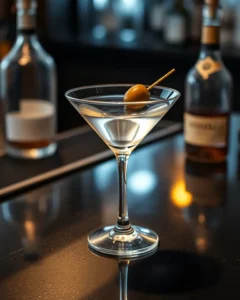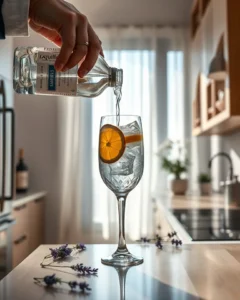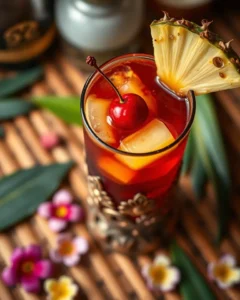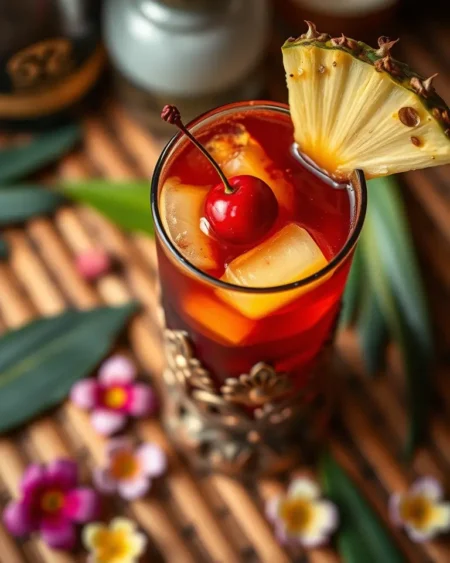The Rum Fruit Cup, also known as Difford’s Cup No.4, is a refreshing and flavorful cocktail that’s perfect for warm weather gatherings. This variation on the classic fruit cup cocktail highlights the beautiful combination of rum and fruit, creating a drink that is both vibrant and easy to enjoy. While the most well-known bottled fruit cup is Pimm’s, many prefer to make their own for a more tailored taste. This article delves into the specifics of the Rum Fruit Cup, exploring its ingredients, preparation, and history.
What is a Fruit Cup?
Fruit cups are quintessentially English summertime drinks, traditionally a mix of fruit, liqueurs, and spices with a base spirit, usually gin. They were initially homemade and intended for home consumption. Pimm’s No. 1, the most recognizable brand, has become synonymous with the category, yet the world of fruit cups extends far beyond this pre-mixed product. Bottled fruit cups are essentially pre-mixed punch-style drinks, typically served with lemonade, ginger ale, or even ginger beer and generously garnished. Many prefer the experience of crafting their own fruit cup to tailor the drink to their liking.
The Rise of Rum-Based Fruit Cups
While gin has traditionally been the spirit of choice for fruit cups, rum offers its own unique profile that is incredibly appealing. In the 1930s-1950s, Pimm’s itself expanded to include a range of different spirits, with Pimm’s No. 4 being a rum-based offering. This paved the way for more rum-centric fruit cup variations that highlight the spirit’s inherent sweetness and spice, leading to the delicious Rum Fruit Cup.
Ingredients for a Rum Fruit Cup
The key to a great Rum Fruit Cup lies in the quality and balance of its ingredients. Here’s a breakdown of what you’ll need:
- Rum: Light golden rum is often preferred, but light white or aged rums can also work well. The choice of rum will significantly impact the final flavor profile. Aged rums provide a deeper, richer taste, while white rums offer a cleaner, crisper profile. For a balanced cocktail, an aged rum around 6-10 years old could be used. Some also suggest a mix of dark or spiced rum with a light rum.
- Orange Curaçao: This orange-flavored liqueur adds citrus notes and complexity. The choice of curaçao influences the drink’s overall flavor, so experiment to find the one you enjoy the most.
- Sweet Vermouth: Sweet vermouth contributes a touch of sweetness and herbal notes, creating depth and roundness in the drink.
- Lemon Juice: Fresh lemon juice provides the necessary acidity, balancing the sweetness of the other ingredients.
- Cola: A splash of cola is crucial in this cocktail, adding a familiar flavor note and a touch of fizz. The combination of rum and cola is a classic one that works incredibly well in this fruit cup, creating a summer, almost tropical feel.
Garnish
Garnishing is crucial for enhancing both the visual appeal and flavor of the cocktail. The ideal Rum Fruit Cup garnish includes:
- Lemon, orange, and strawberry slices
- Mint sprigs
- Borage (an edible flower with a cucumber-like flavor)
How to Make a Rum Fruit Cup
Creating this refreshing cocktail is simple and quick, perfect for both casual gatherings and more sophisticated parties:
- Prepare: Chill a Collins glass and prepare your garnishes.
- Pour: Add all liquid ingredients (rum, orange curaçao, sweet vermouth, lemon juice, and cola) into the glass.
- Add Ice: Half-fill the glass with ice.
- Initial Garnish: Add a citrus slice and a couple of mint leaves to the glass from your prepared garnishes.
- Fill with Ice: Fill the glass to the brim with more ice.
- Final Garnish: Finish by adding the remaining garnish to the top of the drink.
Tips for the Perfect Rum Fruit Cup
- Use quality ingredients: The better the quality of the spirits and juices, the better the cocktail will taste.
- Adjust to your preference: Feel free to experiment with different types of rum, juices, and garnishes to tailor the drink to your liking.
- Chill everything: Make sure all the ingredients are properly chilled before mixing for a refreshing drink.
- Fresh is best: Freshly squeezed juice and freshly cut garnishes will make a noticeable difference in the overall quality.
Variations on the Rum Fruit Cup
While the standard Rum Fruit Cup is a delightful drink, there are many variations you can explore:
- Spiced Rum: Substitute some or all of the light rum with spiced rum for added warmth and complexity.
- Tropical Fruits: Incorporate fruits like pineapple, mango, or passion fruit to create a more exotic flavor profile. Passion fruit pulp is a popular addition.
- Mix of Juices: Try different combinations of fruit juices to create unique flavors. You could also add a splash of pineapple or mango juice, along with lime.
- Different Sodas: Experiment with other sodas such as ginger ale or lemon-lime soda.
- Other Liqueurs: You can also change the flavor by adding a touch of Maraschino Liqueur or Velvet Falernum.
- Homemade syrups: Consider using homemade syrups, such as cranberry apple cinnamon syrup for a unique touch.
Rum Punch
Another popular rum-based drink is the Rum Punch. Typically made with a blend of fruit juices, rum, and grenadine for color. It is easily customizable and can be made as a single serve cocktail or as a large batch for a party. There are various ways to make a Rum Punch, with some including four types of rum (white, spiced, coconut, and a flavored rum), and others with a simple ratio of 1 part sour, 2 parts sweet, 3 parts strong and 4 parts weak. This flexibility makes it a great drink for large gatherings.
A Brief History of Rum
Rum’s history is not just about the spirit itself but also the historical context in which it was born. It begins with sugarcane cultivation, first recorded around 350 BC in India. The spirit’s origin is closely linked to the expansion of trade routes and the demand for sugar, leading to the expansion of slave labor.
The Development of Rum
Sugarcane cultivation spread to the Caribbean, where the ideal climate allowed for increased production. The process of fermentation was used as early as 350 BC and rum emerged as the by-product of sugar production. The spirit quickly became a key export and trade commodity for New England and other colonies. Over the centuries, rum has transitioned from a rough, utilitarian spirit to a more refined and nuanced drink, beloved by cocktail enthusiasts worldwide.
Conclusion
The Rum Fruit Cup is more than just a cocktail; it’s a celebration of summer, combining the rich flavors of rum with the freshness of fruit. Whether you’re hosting a backyard barbecue or simply relaxing at home, this drink is sure to please. With its blend of citrus, spice, and fizz, it offers a balanced and satisfying experience. So, grab your ingredients, prepare your garnishes, and enjoy the delightful taste of a homemade Rum Fruit Cup.







